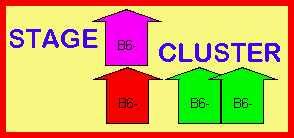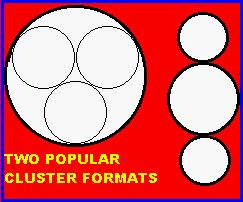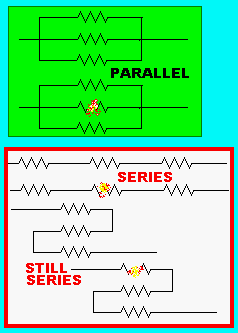Clustering Motors
| DESIGN |
| CG/CP Relation |
| Clustering Motors |
| Nose Cones |
| Rules of Thumb |
| Fin Flutter |
| Conversions |
| Transitions |
| Coning |
 |

"Clustering" is the use of more than one engine fired at the same time. Clustering adds together the thrust level, and thus the lifting or pushing power, of all the engines used. This makes it a good technique for lifting heavy payloads and large rockets.
The thrust curve is different from staging. The diagram shows how. To make your small rocket go twice as high, use two stages. To launch a much larger rocket to single- stage altitude, use a cluster.
 What kind of engines?
Almost any single-stage motor.
In some arrangements, all are the same; in others, types can be mixed.
The rocket at left is flying on one D12-5 and two A10-3T's.
What kind of engines?
Almost any single-stage motor.
In some arrangements, all are the same; in others, types can be mixed.
The rocket at left is flying on one D12-5 and two A10-3T's.
How Many? Two, three, and four engine clusters are common. Experienced modelers cluster five, seven, or more sometimes, but more than four should be considered an advanced technique, because ignition reliability goes down as more engines are used. The better your power supply, the more reliable your clusters will be.
 How are they arranged?
Side by side, almost touching.
Two popular arrangements are shown here. The triangular arrangement
of three motors was used in several early Estes kits, and old-timers like
me who remember those rockets (Ranger, Cobra, Scrambler) tend to automatically
think of this arrangement when the word "cluster" comes up. Three Estes BT-20
motor mount tubes cluster neatly in a BT-60.
How are they arranged?
Side by side, almost touching.
Two popular arrangements are shown here. The triangular arrangement
of three motors was used in several early Estes kits, and old-timers like
me who remember those rockets (Ranger, Cobra, Scrambler) tend to automatically
think of this arrangement when the word "cluster" comes up. Three Estes BT-20
motor mount tubes cluster neatly in a BT-60.
However, one central engine with two, three, or four alongside is a valid and popular format, too, as is a square or diamond-shaped cluster of four.
If three engines are arranged in a triangle, all need to have the same thrust curve, or the rocket will be pushed off course. In a square cluster of four, it's possible to fly with two sets of two, by putting equal engines on opposite corners. Usually in this kind of arrangement, all the engines used have the same delay and ejection charge, so that they reinforce and back up each other.
If there is a central engine, the others can be inside the main body with it or can be attached as outboard pods or "strapons." The outboard engines can be different from the central one, so long as engines on opposite sides of the centerline are balanced. It's common to put a long-burning, low thrust "sustainer" in the center and high-thrust, short burning "booster"* engines outboard. And it's also possible to completely leave out one engine on each side, or to fly the rocket with only the central engine in place.
*In this usage, "booster" does not necessarily mean a zero-delay motor. It means one designed to get the rocket moving quickly, giving it a "boost."
Stability Issues: Two, three, or more engines at the rear end of the rocket concentrates weight where it is least wanted and shifts the CG rearward. Cluster models often need large fins to counteract this. Be sure to test the stability of a new design with the heaviest motors you intend to use in it.
Be Careful of Leakage: Engines are usually mounted in clustered motor mount tubes. The spaces between the tubes need to be filled so ejection charge pressure doesn't leak out there instead of doing its job. Fill the gaps with a putty made from (1) tissue paper and white glue, or (2) epoxy and a filler such as microballoons. You could also cut plywood or balsa plates and glue them in place.
The outboard engines can have the same delay as the center one, and reinforce it; or they may be "booster" engines with zero (or short) delay so that each one ejects itself as it burns out, leaving the center one to activate recovery; or they may be "plugged" engines that stay in place and do nothing at all after burnout. In a few cases the outboard engines may be used to activate the recovery process and the center engine might be plugged. In the rocket above left, the two A10-3T's are in a special collar-shaped carrier that ejects and opens its own parachute while the D12-5 is in its coast phase.
If only part of the cluster is able to activate the recovery system, take extra care to be sure those motors are ignited. It can be expensive and embarrassing, not to mention dangerous, if all the engines fire except the one that opens the parachute.
 Placing engines on fins or otherwise very far from the centerline
is Not Recommended. If one fires and the others don't, such a rocket
will fly in a high-speed loop.
Placing engines on fins or otherwise very far from the centerline
is Not Recommended. If one fires and the others don't, such a rocket
will fly in a high-speed loop.
How are they wired? In parallel, so that when one ignitor burns through, there is still power flowing through the others. If the ignitors are wired in "series," when one ignitor burns, the circuit is broken. Notice in the diagram that the ignitors can physically be lined up alongside each other and still be wired in series. Use of a "clip whip" is recommended.
Does launching a cluster take extra battery power? Yes. A car battery is best. Four fresh alkaline "D" cells or a fully charged 9.6v RC car battery pack will fire a cluster of three Solar ignitors or electric matches reliably, but 4 AA cells generally will not. In general, fully charged NiCad rechargeables are much better than alkalines.
Clustering and Staging Together: Generally Not Recommended. Usually, if blow-through staging is used to stage from one cluster to another, the first upper-stage engine to ignite separates the stages before any others can start. However, there are certain ways staging and clustering can be combined. A booster stage can have plugged or capped outboards, while an open-topped central engine fires the single engine in the upper stage. (John O'Donnell's staged and clustered Fat Boy uses this method.) Electrical means can be used to fire a cluster in the upper stage, clearly an advanced technique. Some people have had good results with a gap-staging methods, and some have used Thermalite or a sprinkle of loose black powder to interconnect the upper-stage nozzles. George Gassaway uses CHAD staging so that each booster engine can drop off independently. Before you attempt this, be sure you understand staging, clustering, and stability thoroughly, and that you are comfortable with the power (and expense!) you are turning loose.
Clustering Composites: Unlike staging, clustering is almost as easy to do with some composite engines as it is with black powder; but this should still be considered an advanced technique, if only because a lot of power will be involved. Some composite propellants are difficult to ignite, and some kinds of ignitors are unsuitable for clustering. In general, the smoky, slow-burning composites, such as BlackJack and the Apogee long burn motors, are more difficult to ignite and unreliable for clustering. On the other hand, the popular AeroTech G80s, with Blue Thunder propellant, can be easily clustered if electric matches are used to ignite them. The pigtails of three or more electric matches can be twisted together in the manner shown for clip whips.
See the article on building Clip Whips for igniting your clusters in the GROUND SUPPORT area.
Submitted by Peter W. Clay (peterlynnc@aol.com)
